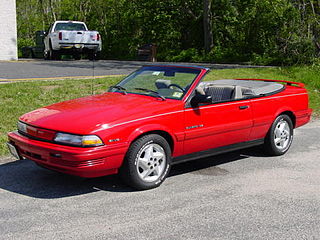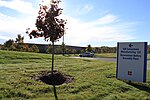
The Pontiac Sunbird is a model line that was manufactured and marketed by Pontiac from the 1976 to the 1994 model years. Loosely deriving its name from the Pontiac Firebird, the Sunbird was introduced as the eventual replacement for the Pontiac Astre, replacing it entirely in 1978 as the smallest Pontiac.

The General Motors E platform or E-body was the automobile platform designation used for a number of personal luxury cars produced from 1963 to 2002. Notably, early E-bodies were produced in both front wheel drive and rear wheel drive configurations, and were the first front wheel drive automobiles produced in the United States since 1937. The initial front-wheel drive E-platform power plant was referred to as the Unitized Power Package (UPP).

The Buick Reatta is a low-volume transverse front-engine, front-wheel drive, two-door, two-seater grand tourer manufactured and marketed by Buick as a coupe (1988–1991) and convertible (1990-1991) — both featuring a 3.8 liter V6 engine and shortened version of the GM E platform, shared with the seventh generation Buick Riviera.
American Specialty Cars was an automobile supplier of highly engineered and designed roof systems, body systems and other specialty-vehicle systems for the world’s automakers. The company was headquartered in Warren, Michigan, in the United States and was one of several coach convertible builders. ASC sold assets to its Creative Services division in late 2016 to Roush Industries. In late June 2017, ASC effectively ceased operations, laying off all staff and had tooling and production equipment removed from the manufacturing plant in Lexington, Kentucky.

Lansing Car Assembly was a General Motors automobile factory in Lansing, Michigan. It contained two elements, a 1901 automobile plant in downtown Lansing, and the 1920 Durant Motors factory on Lansing's Far Westside.
Arlington Assembly is a General Motors automobile factory located in Arlington, Texas. The plant has operated for more than 60 years and today manufactures large SUVs from GM's divisions Chevrolet, GMC and Cadillac.

Doraville Assembly was a General Motors automobile factory in Doraville, Georgia, just northeast of Atlanta. The plant opened in 1947 and was under the management of GM's newly created Buick-Oldsmobile-Pontiac Assembly Division created in 1945. It was closed on 26 September 2008 as part of the company's cost-cutting measures. According to an article that appeared in the Atlanta Journal-Constitution on January 28, 2010, New Broad Street Doraville, LLC, a development company, has executed a purchase contract with General Motors to purchase the former plant, with plans to build a mixed-use, transit-oriented development. New Broad Street's deal fell through when, DeKalb County decided against using its federal stimulus and property taxes dollars to partially fund the project.

Wilmington Assembly was a General Motors automobile factory in Wilmington, Delaware. The 3,200,000-square-foot (300,000 m2) factory opened in 1947, and produced cars for GM's Chevrolet, Pontiac, Saturn, Opel, Buick and Daewoo brands during its operation. GM closed the plant on July 28, 2009.
Linden Assembly was a General Motors automobile factory in Linden, New Jersey. The plant operated from 1937 to 2005 and made cars, trucks and SUVs for various GM automotive divisions. Engine block and cylinder heads were cast at Saginaw Metal Casting Operations, internal engine components were created at Bay City Powertrain and the engines were then assembled at assembled at Tonawanda Engine and Romulus Engine.
Leeds Assembly was a General Motors automobile factory in Leeds, Missouri. It was closed in 1988. The factory produced the A-bodies and J-bodies.
Detroit/Hamtramck Assembly, also called Factory Zero, is a General Motors automobile assembly plant straddling the border between Detroit and Hamtramck, Michigan. It is located about three miles (five km) from GM's corporate headquarters. When the facility opened, it was built on the original "Dodge Factory" location that was built in 1911, which was closed in 1980 and demolished in 1981, and the new GM factory built vehicles for GM's "BOC" (Buick/Oldsmobile/Cadillac) Group. The first vehicle, a Cadillac Eldorado, rolled off the assembly line on February 4, 1985.

Oshawa Assembly is a manufacturing facility in the city of Oshawa, Ontario, Canada, that built various automobiles for General Motors Canada. Vehicles were primarily produced for the US, Canadian, and Mexican markets, but they also built exports for various countries around the world, particularly South America and the Middle East. Historically the Oshawa plant was the source of all right-hand-drive market GM exports with complete vehicles or knock-down kits shipped to Australia, New Zealand, South Africa, and the United Kingdom until the end of the 1960s. At one time, the factory was one of the largest auto manufacturing facilities in the world, with two car assembly plants, a truck assembly plant, as well as parts production including Harrison radiators, AC Delco batteries and American Axle. Between 1999 and 2019, it had won more quality and productivity awards than any other GM plant. The plant is part of the larger GM Autoplex.
Spring Hill Manufacturing is a General Motors factory in Spring Hill, Tennessee. The plant currently includes vehicle assembly as well as powertrain, stamping and molding operations. The plant originally operated as the sole manufacturing facility for Saturn Corporation.
Lansing Delta Township Assembly is a General Motors automobile assembly factory in Delta Township, Michigan on land that is shared by the township and the nearby city of Lansing. It manufactures Chevrolet, and Buick vehicles.
The Lansing Metal Center was a General Motors foundry located in Lansing Township, Michigan directly across Saginaw Street from the Lansing Craft Center. It was originally built as a jet engine manufacturing plant in 1952 and shuttered in 2006.
Pontiac Assembly was one of four General Motors assembly plants in Pontiac, Michigan located along Baldwin Avenue. It served as the home factory for GM's Pontiac Motor Division since it was built in 1927. It was across the street from the currently operational Pontiac Metal Center, which was the original location for the Oakland Motor Car Company, which Pontiac evolved out of. It was also sometimes identified as being located in the city of Bloomfield, Michigan.
South Gate Assembly was a General Motors automobile plant located at 2720 Tweedy Boulevard in the Los Angeles suburb of South Gate, California. It opened in 1936 to build B-O-P (Buick-Oldsmobile-Pontiac) cars for sale on the west coast. It was the first GM plant to build multiple car lines, resulting from a Depression-spawned move to cut production costs by sharing components and manufacturing. South Gate was the second of several B-O-P "branch" assembly plants, part of GM's strategy to have production facilities in major metropolitan cities. Engine block and cylinder heads were cast at Saginaw Metal Casting Operations, internal engine components were created at Bay City Powertrain and the engines were then assembled at Tonawanda Engine and Romulus Engine.

Lansing Manufacturers Railroad was a beltline switching railroad organized in 1904 to connect Cornelius Vanderbilt's Michigan Central mainline on the north edge of Lansing, Michigan, to automotive factories on the west and south side of the city and to Sir Henry Tyler's Grand Trunk Railroad along the north bank of the Grand River. The company's 5.1-mile (8.2 km), C-shaped right of way lay entirely within the city limits. Important customers included GM's Reatta Craft Centre, Lansing Metal Center, and both plants of Lansing Car Assembly.
The Ramos Arizpe Assembly is a General Motors automobile factory in Ramos Arizpe, Coahuila, Mexico. It opened in 1981 and has manufactured Buick, Cadillac, Chevrolet, GMC, Oldsmobile, Pontiac, Saturn, and Saab vehicles. It currently produces the Chevrolet Blazer and, along with San Luis Potosi Assembly, the Chevrolet Equinox.
Saginaw Metal Casting Operations is an automobile engine foundry plant in Saginaw, Michigan. Opened under GM management in 1919, the factory produces engine blocks and cylinder heads for General Motors vehicles. The factory currently occupies 1.9 million square feet on 490 acres. The location was originally the Marquette Motor Company until acquired by William Durant in 1909 when the car was discontinued in 1911. During World War I, it was used to manufacture mortar shells for the US Ordnance Corps, then was repurposed for engine block casting when operations at Northway Motor and Manufacturing Division ended in 1925. Historically in September 1927 it was known as the Chevrolet Grey Iron Foundry. In the past when it was called GM-Saginaw Product Company (SPC) a cloverleaf casting symbol mark was cast onto the iron component.









